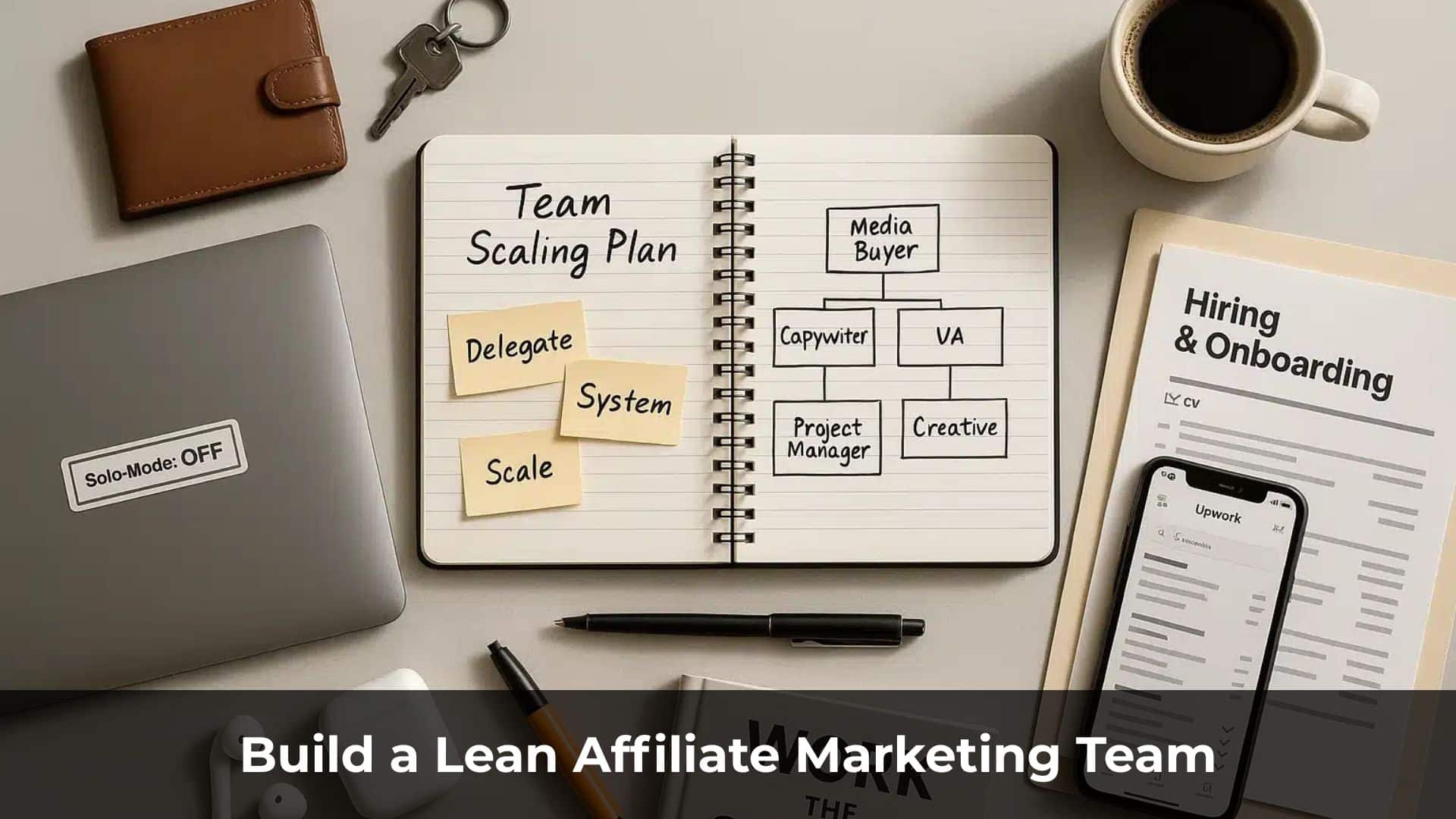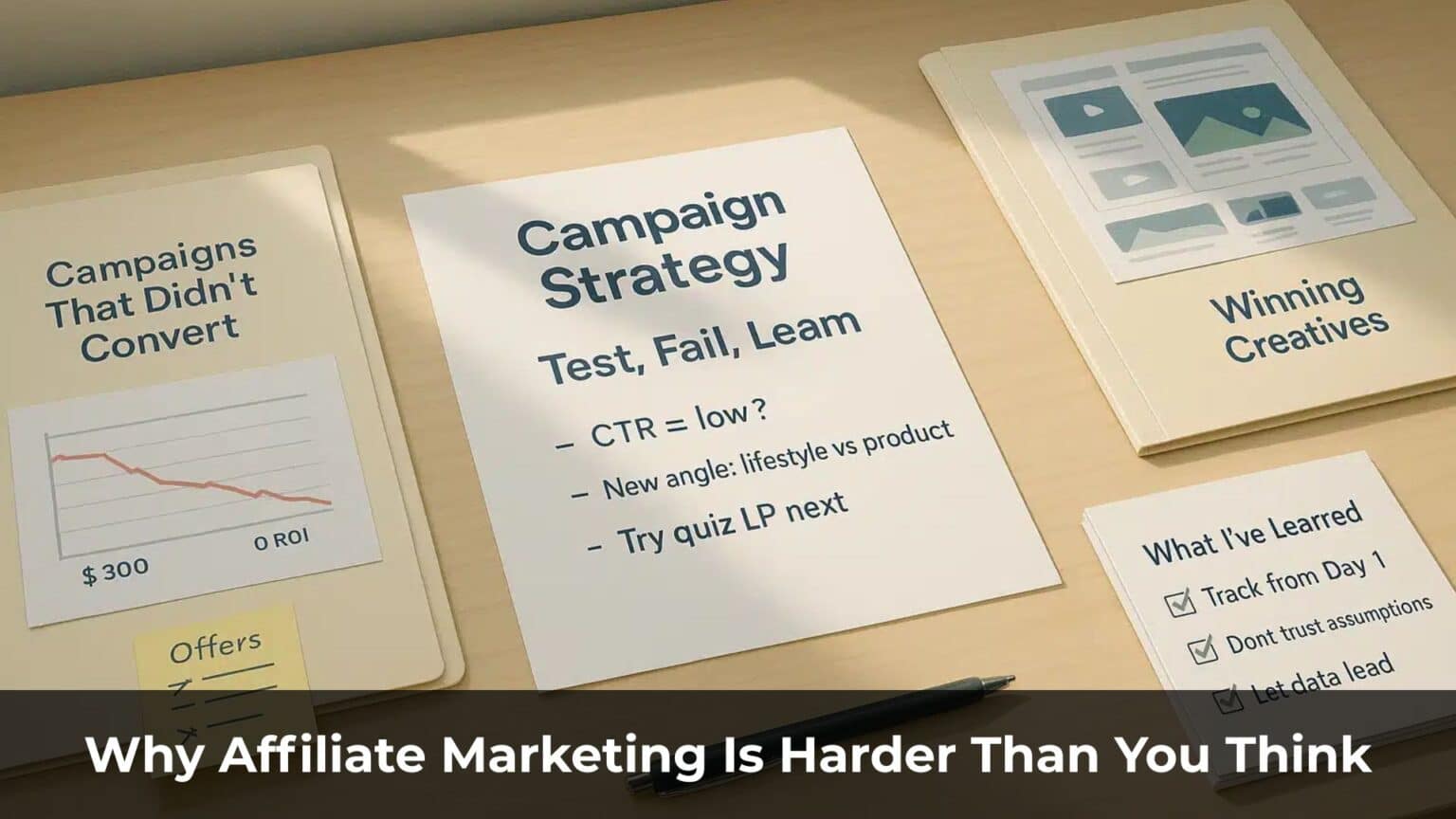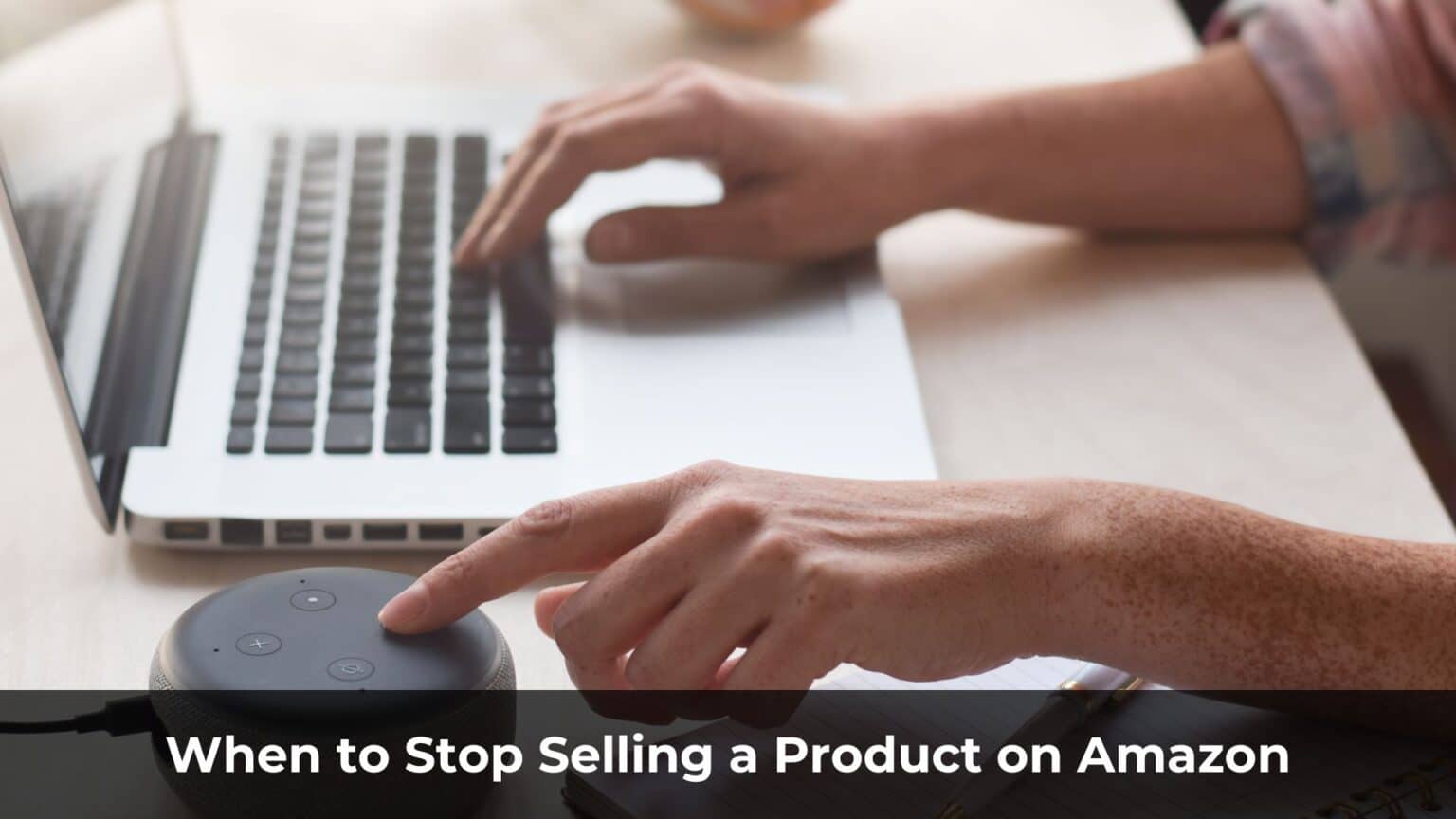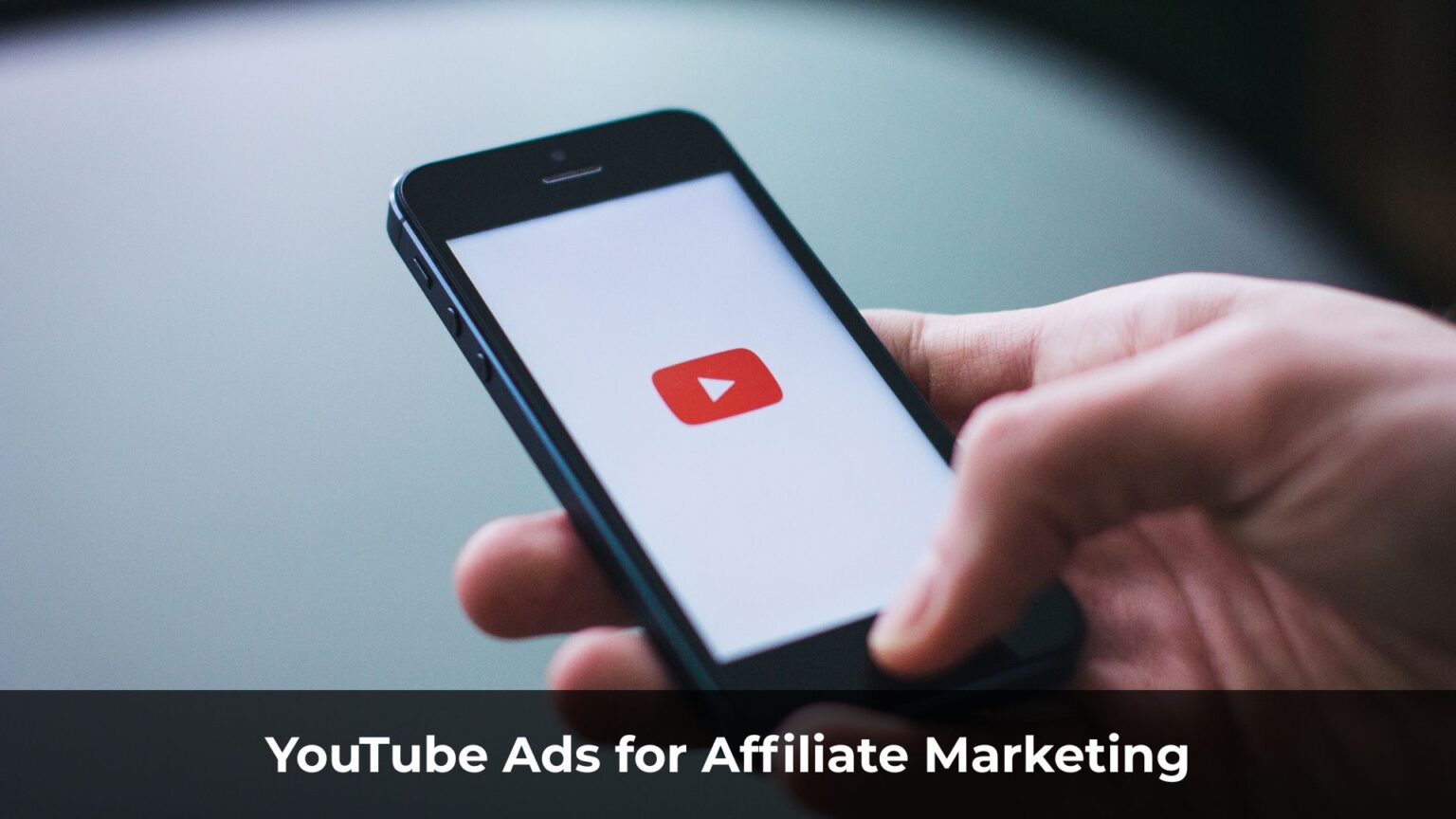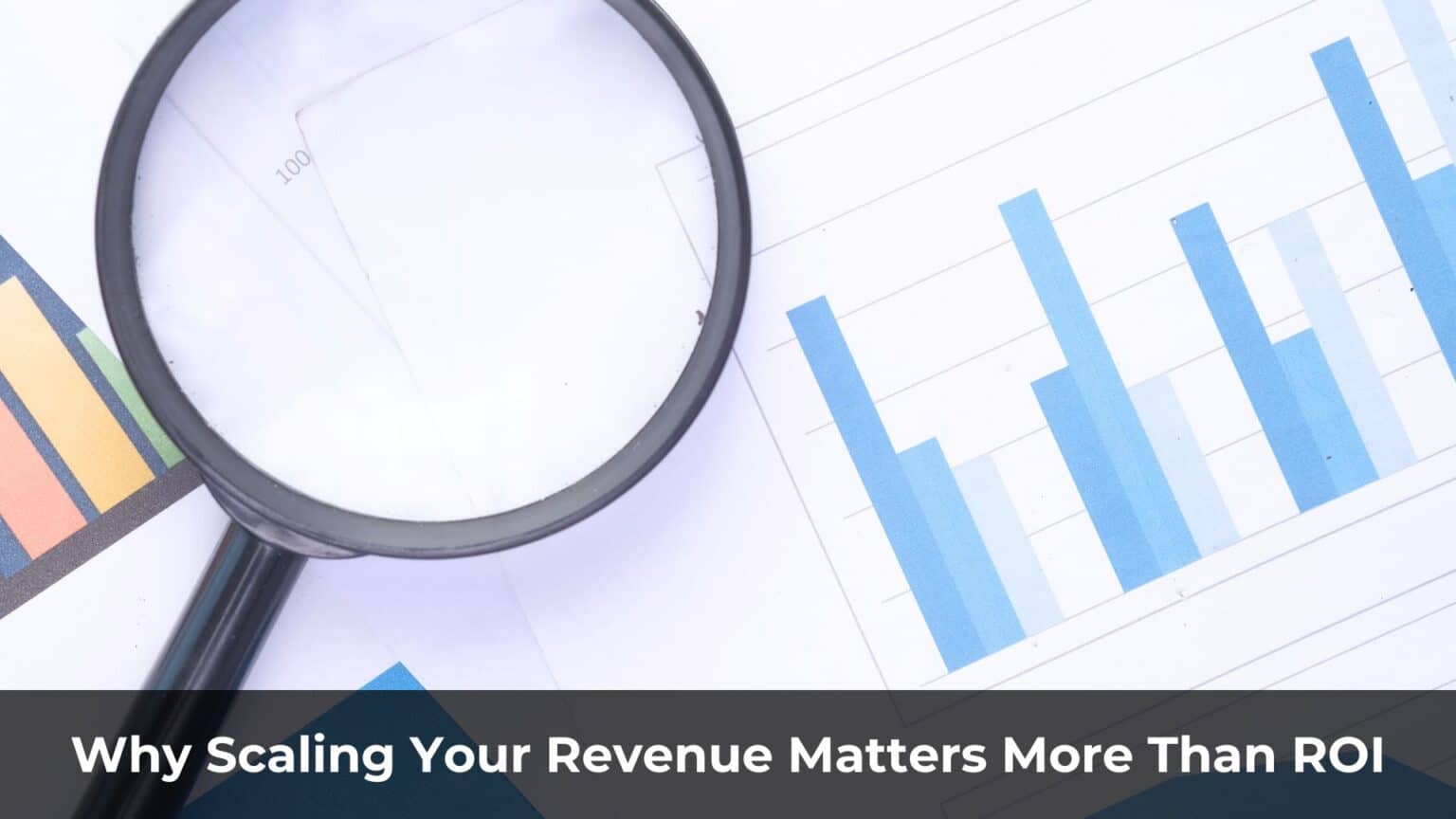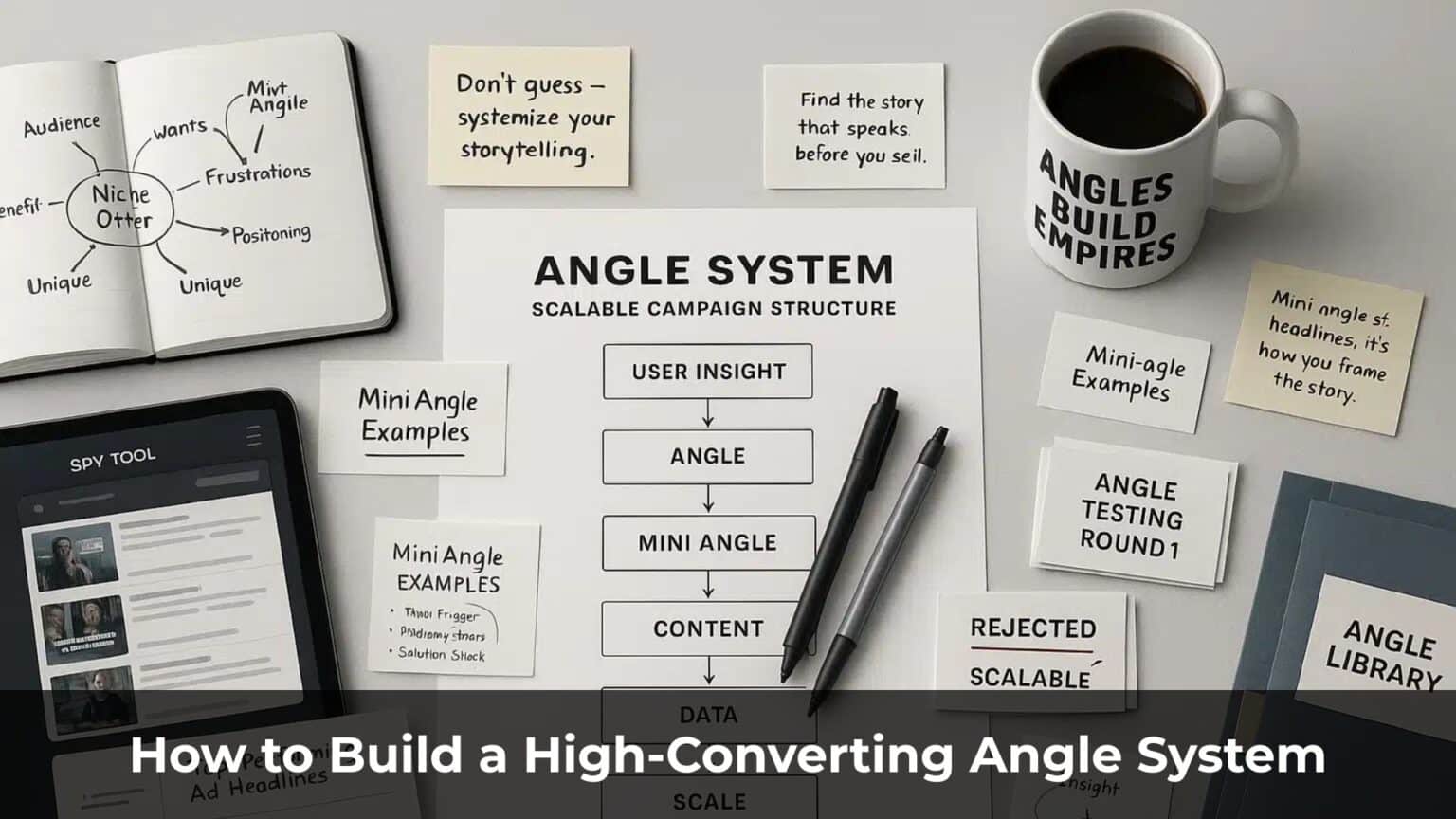Maybe you’re reading this because you’re like I used to be – a lone wolf affiliate marketer, grinding day and night, handling everything from A to Z yourself. Sound familiar? I’ve been there.
My income wasn’t bad, not bad at all. But behind the scenes? Months flew by where I barely had time for myself, let alone strategic growth.
Writing content, creating videos, building landing pages, setting up ads, configuring tracking… every single task landed squarely on my plate.
I took a certain pride in that versatility, in being a self-sufficient “one-person army.”
But the truth? The cost was too high. I realized I was trapped in a cycle of doing, not growing. Even though I was making decent money (hitting 6 figures), I couldn’t scale any further.
There’s a hard limit to what one person can achieve, and I knew I couldn’t keep carrying the entire operation alone if I wanted to reach the next level (7 or even 8 figures).
Going solo in affiliate marketing can get you started, maybe even make you good money initially. But to build a truly sustainable, scalable business and achieve the freedom that attracted you in the first place, you cannot do it all yourself indefinitely.
That’s why I’m writing this. This isn’t about bragging; it’s about sharing the hard-won, practical lessons I learned about building an affiliate marketing team the right way – lean, effective, and built for scale.
You don’t need a massive, bloated payroll. You just need a few key, highly skilled specialists in the right roles, working together like a well-oiled machine.
Consider this your field guide to escaping the “solo operator trap” and genuinely scaling up your affiliate marketing career.
Let’s dive in.
Table of Contents
ToggleWhen Do You Really Need to Build a Team?
I get asked this a lot: “I’m just starting in affiliate marketing, should I hire people right away?” My answer is almost always: Probably not yet.
Building a team isn’t a race or a status symbol. It must stem from the genuine needs of your business right now.
So, what are the clear signals that it’s time to bring in reinforcements?

Signal #1: You’re Drowning in Repetitive Operational Tasks.
Are you spending the bulk of your day on things like basic campaign setup, tweaking landing pages from templates, pulling simple reports, managing social media profiles, or handling routine admin?
These tasks are necessary, sure, but they offer very little leverage for significant growth. They are often $10/hour tasks.
If you find yourself constantly bogged down by the operational weeds, with no headspace left for strategy, research, or finding new opportunities, it’s a flashing red light: you need support.
Signal #2: You Want to Scale Significantly But Feel Maxed Out.
You have ambitions: run more campaigns, test more niches, explore new traffic sources, tackle more complex offers. But there are only 24 hours in a day, and you’re already stretched thin.
Trying to do everything yourself becomes the bottleneck. Your personal capacity limits your business growth. You know you could be making more, but you simply lack the bandwidth.
Want to jump from 6 figures to 7, or 7 to 8? It’s highly unlikely you can make that leap alone.
Signal #3: You Need to Reclaim Your Time for High-Leverage Activities (and Life).
What should you be focusing on? Deeper market research, building strategic relationships with Affiliate Managers (AMs) for better payouts and insights, mastering new high-value skills, networking with other successful marketers, or simply… having a life outside of work?
Spending time with family, pursuing hobbies, taking care of your health?
If your affiliate business is consuming your entire existence, preventing you from focusing on the 20% of activities that drive 80% of the results (or just burning you out), it’s time to delegate.
Crucial Foundation: In the beginning, it’s vital that you understand and can competently perform every core function of affiliate marketing yourself – research, content, creatives, tracking, optimization.
This hands-on experience gives you invaluable perspective, helps you set realistic expectations, and teaches you how to manage effectively later.
But don’t let “knowing how” become an excuse to “always do.” Once you hit a certain revenue level or feel the constraints above, building a lean team becomes the essential next step for sustainable, long-term success.
If one or more of these signs hit home, congratulations – it’s time to get serious about building your team!
The Core Cogs in Your Lean Affiliate Marketing Machine
Alright, you’re ready to build. But how? Who do you actually need?
Forget the idea of needing a huge staff right away. My experience, especially scaling through the 6 and 7-figure levels, taught me that quality and synergy trump sheer quantity.
You don’t need an army; you need a few core specialists – people who are genuine experts in their specific function and who collaborate effectively.
The Goal: Build a lean but lethal team. Each member is a master of their craft, enabling your affiliate engine to run faster, smoother, and more powerfully.
So, what are these indispensable roles? Based on my journey, here are the 5 critical positions to consider first:
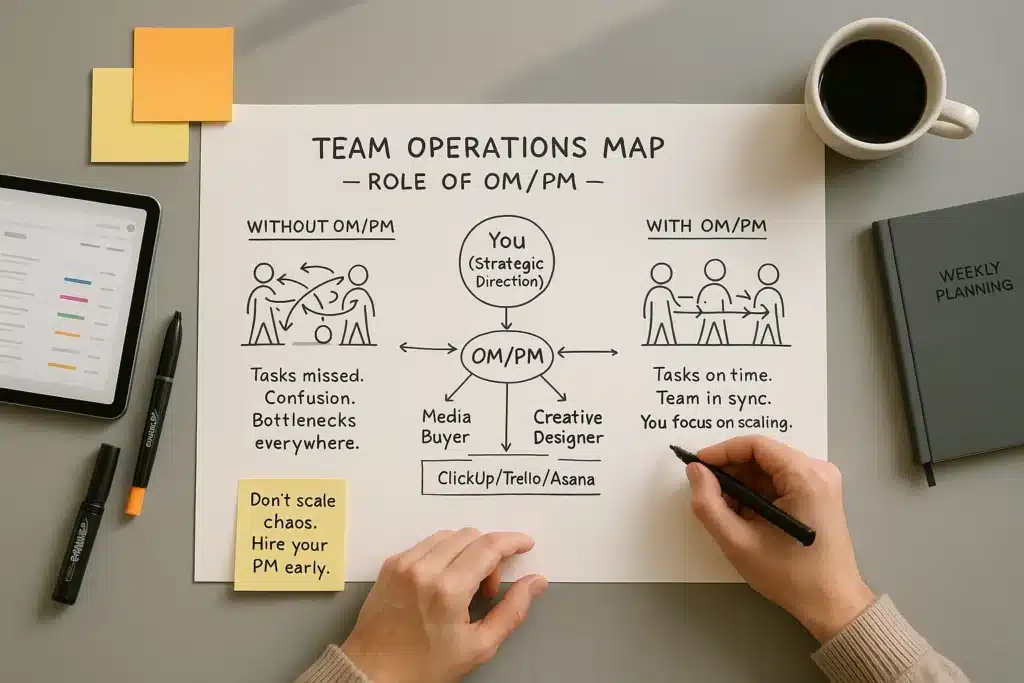
Cog #1: Operations / Project Manager (OM/PM) – Your Indispensable Right-Hand
For the longest time, my team’s biggest bottleneck wasn’t traffic or offers… it was me. I tried juggling the OM/PM role myself, but my management and communication skills were, frankly, terrible. Everything felt chaotic.
Things only truly clicked and started flowing smoothly when I hired a dedicated, skilled OM/PM.
Why hire them early? Because they are the central hub, the conductor of your orchestra. Without a good OM/PM, your team (even a small one) can easily become disjointed, tasks get dropped, communication breaks down, and progress grinds to a halt.
Primary Duties: They manage the day-to-day workflow. They oversee project timelines using tools like Asana, Trello, Monday.com, or ClickUp, ensure tasks are clearly assigned and completed on schedule, facilitate seamless communication between team members (and with you), troubleshoot operational hiccups, and provide you with clear progress reports.
You delegate the strategic direction (e.g., “Goal this week: Test 2 new offers in X niche, scale campaign Y, need 10 new ad creatives for Z traffic source”), and the OM/PM translates that into actionable tasks and manages the execution.
Key Requirements: Exceptional organizational skills are non-negotiable. Strong, clear communication is paramount.
They need a solid general understanding of the affiliate marketing process (they don’t need to be a media buying or copywriting expert, but they need to understand the pieces).
Crucially, they must excel at managing people, processes, and project details.
Hiring Sources & Cost:
- Priority #1: Your Network. Ask trusted colleagues or mentors for recommendations. A referral significantly de-risks the hiring process.
- Professional Platforms:
- LinkedIn: Excellent for finding experienced professionals with specific backgrounds.
- Upwork: Can find great talent, but requires rigorous screening and clear project definition. Look for those with proven experience managing marketing or digital agency teams.
- Specialized Marketing Job Boards: Boards focusing on remote marketing or operational roles.
Cost: Highly variable based on experience and location. Expect ranges from $30 – $75+ per hour for skilled freelance/remote OM/PMs, particularly those based in North America or Western Europe. You might start part-time (e.g., 10-15 hours/week) and scale up as your team and operational complexity grow.
Do not underestimate this role. A great OM/PM doesn’t just manage tasks; they buy back your time, reduce your stress, and create the operational stability needed to scale effectively. They allow you to focus on CEO-level activities.

Cog #2: Virtual Assistant (VA) – Your Task Execution Powerhouse
The Virtual Assistant is often the first hire for overwhelmed solo affiliates, and for good reason. They take over the essential but repetitive, time-consuming tasks that don’t require deep strategic input, freeing you up immediately.
Typical Tasks:
- Basic System Admin: Setting up and managing ad accounts (initial setup, basic checks), Business Managers, pixels, domains (following clear instructions).
- Landing Page Implementation: Taking existing templates and content, updating text, swapping images, ensuring links work. Focus is on execution, not creative design or copywriting.
- Tracking Link Setup: Implementing tracking parameters in tools like Voluum, Binom, RedTrack, etc., based on your specifications.
- Data Entry & Reporting: Compiling simple performance reports from dashboards.
- Social Media Management: Basic posting, comment moderation (non-strategic).
- Other Defined Processes: Any task that is well-documented and follows a clear, repeatable process.
Key Requirements: Detail-oriented, reliable, consistent, and excellent at following instructions precisely. Strong communication for clarification is needed, but deep strategic thinking isn’t the primary requirement.
Look for conscientiousness and a proactive attitude towards asking questions if unsure.
Hiring Sources & Cost:
- Specialized VA Platforms: Platforms like OnlineJobs.ph are well-known for sourcing VAs, particularly from the Philippines, often at very competitive rates. This can be a great starting point, especially for cost-sensitive operations.
- General Freelance Platforms: Upwork and Fiverr have vast pools, but quality varies immensely. Requires very careful screening and potentially trial tasks.
- Referrals: Ask other marketers if they know reliable VAs.
Cost: Can range widely. For VAs from lower cost-of-living regions (like the Philippines via OnlineJobs.ph), rates might be $8 – $15+ per hour. For VAs with more specialized marketing skills or based in higher cost-of-living areas, expect $15 – $30+ per hour.
Important Note on Hiring VAs: Platforms like Upwork and OnlineJobs.ph can sometimes be flooded with low-quality or automated applications, especially since the rise of AI.
Implement smart filtering in your job posts (e.g., ask specific questions, request a brief Loom video intro) to weed out non-serious candidates (more on this later).
A good VA is a force multiplier. They handle the operational drag, giving you back precious hours to focus on revenue-generating activities.
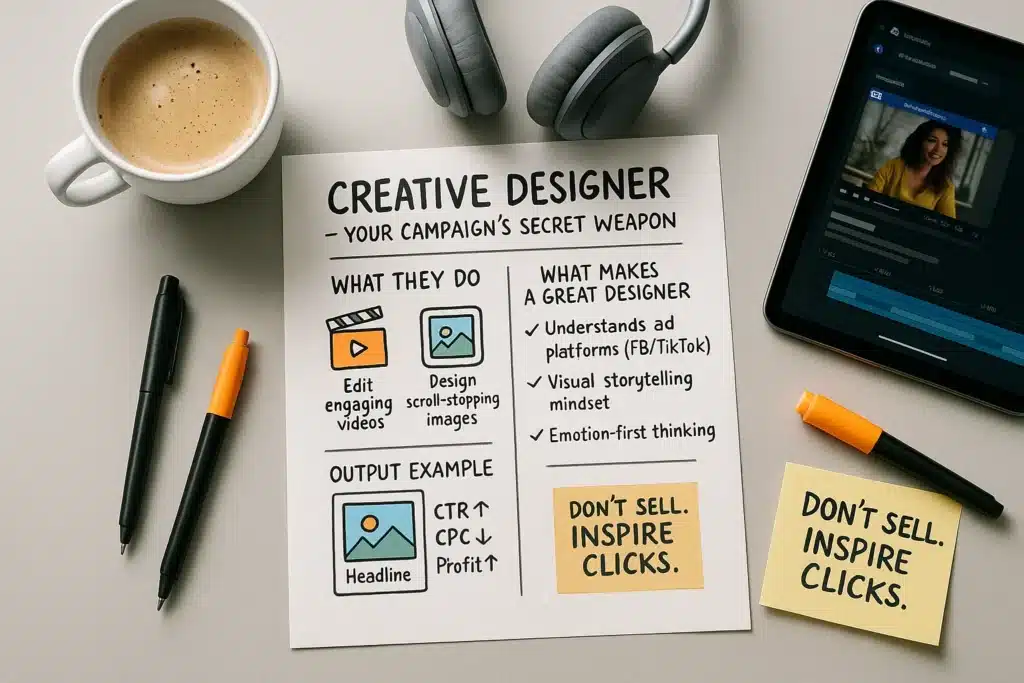
Cog #3: Creative Designer – Your Campaign’s Visual Architect
In the hyper-competitive world of paid affiliate advertising, your creatives (ad images and videos) are often the single biggest lever for success.
A mediocre creative gets ignored; a great one stops the scroll, captures attention, and drives clicks. You need more than just a graphic designer; you need someone who understands direct response design.
Primary Duties: Conceptualize and produce compelling, attention-grabbing ad creatives (videos, static images, GIFs) optimized for specific platforms (Facebook, Instagram, TikTok, YouTube, Native, etc.).
They need to translate marketing angles into visuals that evoke emotion and spur action.
They should understand visual storytelling, platform best practices, and how to create variations for effective split-testing.
Key Requirements: Strong visual design skills (video editing, graphic design, motion graphics are bonuses). Crucially, a marketing mindset – they must understand CTR, conversion goals, and how design impacts performance.
Experience creating ads for direct response campaigns is highly desirable. Ability to work fast and produce variations is key.
Hiring Sources:
- Portfolio Platforms: Behance and Dribbble are great for seeing work quality, though finding designers focused specifically on direct response ads can take digging.
- Freelance Marketplaces: Upwork and Fiverr have relevant categories, but vet portfolios very carefully. Look for examples of actual ad creatives, not just general branding or web design.
- Niche Communities: Facebook groups or Discord servers dedicated to ad creative professionals, performance marketing design, or video ads.
- Referrals: Ask successful media buyers or other affiliates who designs their winning creatives.
Cost: Often project-based (per creative) or hourly. Expect $75 – $250+ per ad creative set (e.g., a video + related image variations) depending on complexity, length, and the designer’s experience/location.
Hourly rates typically range from $40 – $100+ per hour. Top-tier direct response designers command premium fees.
Don’t treat creative as an afterthought! It’s a core pillar of paid traffic success. Investing in a skilled creative designer pays for itself many times over through better campaign performance (higher CTR, lower CPA).
Note on AI: While AI image and video tools are rapidly improving and can be useful for inspiration or initial concepts, they currently lack the nuanced understanding of persuasion, emotion, and platform context that a skilled human designer brings, especially for direct response.
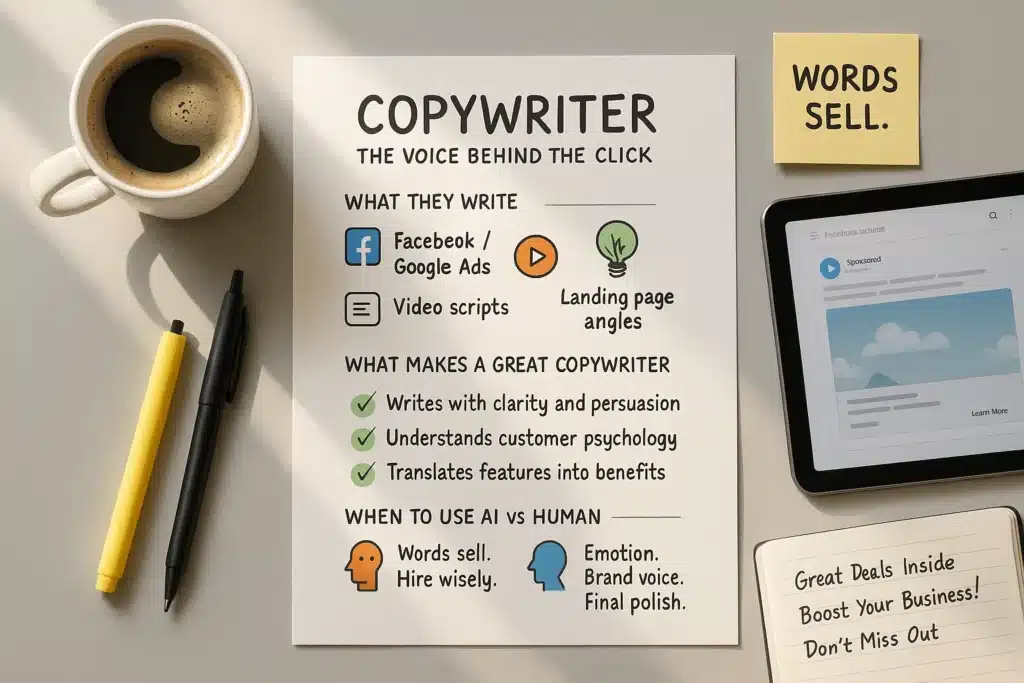
Cog #4: Direct Response Copywriter – The Voice That Sells
If creatives are the hook, copy is the reel and the line. It’s the persuasive messaging in your ads, landing pages, and scripts that convinces someone to click, sign up, or buy.
A great direct response copywriter understands psychology, knows how to craft compelling angles, and uses words to drive specific actions.
Primary Duties: Write clear, concise, and persuasive ad copy (headlines, body text, CTAs) for various platforms. Develop scripts for video ads. Write high-converting landing page copy (headlines, bullets, body, CTAs). Craft email sequences if applicable.
Key Requirements: Exceptional writing skills focused on clarity, persuasion, and conversion. Deep understanding of customer psychology, pain points, and desires within your niches.
Ability to research and develop powerful marketing angles. Mastery of direct response principles (AIDA, PAS, etc.). Ability to adapt tone and style.
Hiring Copywriters:
- Specialized Job Boards & Communities: Boards like the Cult of Copy Job Board or Nothing Held Back (NHB) Job Board are excellent places to find writers specializing in direct response. High-quality private Facebook groups for copywriters are also valuable.
- Referrals: Ask trusted marketers or copywriters you respect for recommendations.
- Upwork: Can find talent, but requires meticulous vetting of portfolios and potentially a paid trial project. Look specifically for experience with direct response ads and landing pages in your niche.
- Avoid: General content writers or bloggers usually lack the specific skillset needed for conversion-focused affiliate copy.
Cost: Typically project-based, per word, or hourly. Rates vary wildly based on skill and results. Expect $100 – $500+ for a set of ad copy variations or a key landing page section. Top-tier direct response copywriters often charge significantly more, sometimes including performance incentives.
AI vs. Human?
- Use AI (ChatGPT, Claude, Jasper etc.) for: Brainstorming angles, generating initial ideas, outlining copy structure, overcoming writer’s block, summarizing research.
- Need a Human for: Deep customer empathy, crafting unique and powerful angles, injecting personality and brand voice, ensuring emotional resonance, refining clarity and flow, and the final persuasive polish.
Copywriting isn’t just about stringing words together; it’s about understanding minds and motivating action. A skilled direct response copywriter is an investment that directly impacts your bottom line.
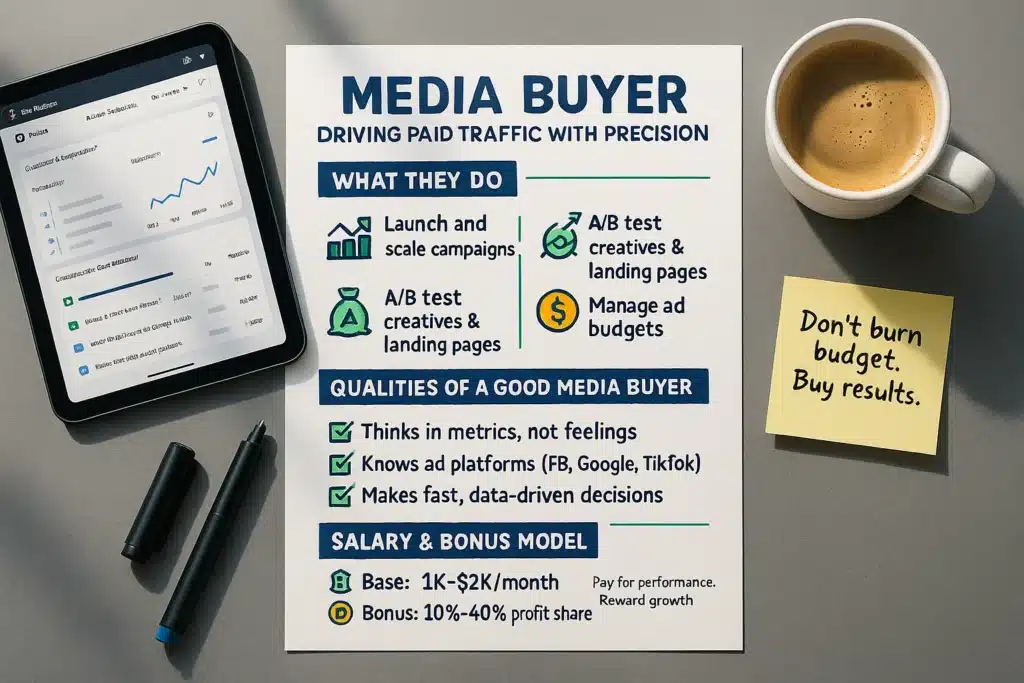
Cog #5: Media Buyer – Your Traffic & Optimization Expert
This is the person with their hands on the steering wheel of your paid traffic campaigns. They manage your ad spend, navigate the complexities of platforms like Facebook Ads, Google Ads, TikTok Ads, Native platforms, etc., and relentlessly optimize for profitability (ROI/ROAS).
Primary Duties: Develop campaign strategies (targeting, bidding, budget allocation). Set up and launch campaigns across various platforms.
Monitor performance data daily/hourly. Analyze metrics (CTR, CPC, CPA, Conversion Rate, ROI).
Make data-driven decisions to optimize campaigns (adjust bids, targeting, creatives, landing pages). Scale winning campaigns and cut losers quickly. Manage ad budgets effectively.
Two Main Hiring Approaches:
Hire Experienced: Look for someone with a proven track record of managing significant ad spend profitably in your niches or on your target platforms.
- Pros: Can hit the ground running, potentially brings existing knowledge/strategies.
- Cons: Higher cost, harder to find truly skilled buyers (many talk, few deliver), requires rigorous vetting of actual results (ask for proof/case studies).
Hire for Potential & Train: Find someone smart, analytical, detail-oriented, highly motivated, and ethically sound (perhaps a sharp VA ready to level up, or a bright graduate). Train them meticulously in your methods and systems.
- Pros: Lower initial cost, can instill your specific processes, potentially higher loyalty.
- Cons: Requires significant investment in your time for training and mentorship, slower ramp-up time, risk they may leave after training.
Compensation Structure (Absolutely Critical!):
Base Salary: Provides stability. This varies hugely based on location and experience. For remote talent in lower COL regions, it might start around $1,000 – $2,500/month.
For experienced buyers in the US/UK/Western Europe, base salaries can be $4,000 – $8,000+/month or significantly more.
Performance Incentive (% of Profit): This is non-negotiable for aligning incentives. Offer a clear percentage of the net profit generated by the campaigns they manage.
This could range from 10% – 20% for junior/mid-level buyers up to 30% – 50% for highly skilled, senior buyers who drive substantial profit. The exact structure depends on the base salary and overall deal.
Clear KPIs & Reporting: Define exactly how profit is calculated and tracked. Establish clear performance expectations (KPIs) and reporting requirements.
Risk Management: Media buyers control your ad spend – potentially large amounts. Implement checks and balances: clear budget limits, regular performance reviews, potentially dual access controls on ad accounts initially.
A great media buyer isn’t just a button-pusher; they are a strategic partner in profitability. Finding and retaining a good one is a massive competitive advantage.
Beyond the Core 5: Depending on your scale and strategy, you might eventually need other roles like SEO specialists, email marketers, developers, data analysts, etc. But these five form the essential foundation for most scaling affiliate businesses relying on paid traffic or complex funnels.
Finding Your A-Team: Where and How to Hire Effectively
Knowing who you need is half the battle. Now, how do you find and attract the right people?
Where to Look (Recap & Nuances)?
Your Network (Gold Standard): Always start here. Ask trusted colleagues, mentors, or people in relevant communities for recommendations. A referral is the warmest lead.
Specialized Platforms/Communities:
- Copywriters: Cult of Copy Job Board, NHB Job Board, high-quality Facebook groups.
- Designers: Behance/Dribbble (portfolio review), Upwork (filtered search), niche design communities.
- Media Buyers: Referrals are best. LinkedIn, specialized marketing job boards. Sometimes found in high-level marketing communities (paid groups often have talent).
- OM/PMs: LinkedIn, Upwork (look for agency/marketing PM experience), referrals.
- VAs: OnlineJobs.ph (cost-effective, Philippines focus), Upwork, Fiverr (careful vetting needed), specialized VA agencies.
General Platforms (Use with Caution):
- Upwork/Fiverr: Can work for all roles, but require excellent job post clarity and rigorous screening due to high volume and variable quality.
- LinkedIn: Best for more experienced, professional roles (OM/PM, senior media buyers/copywriters).
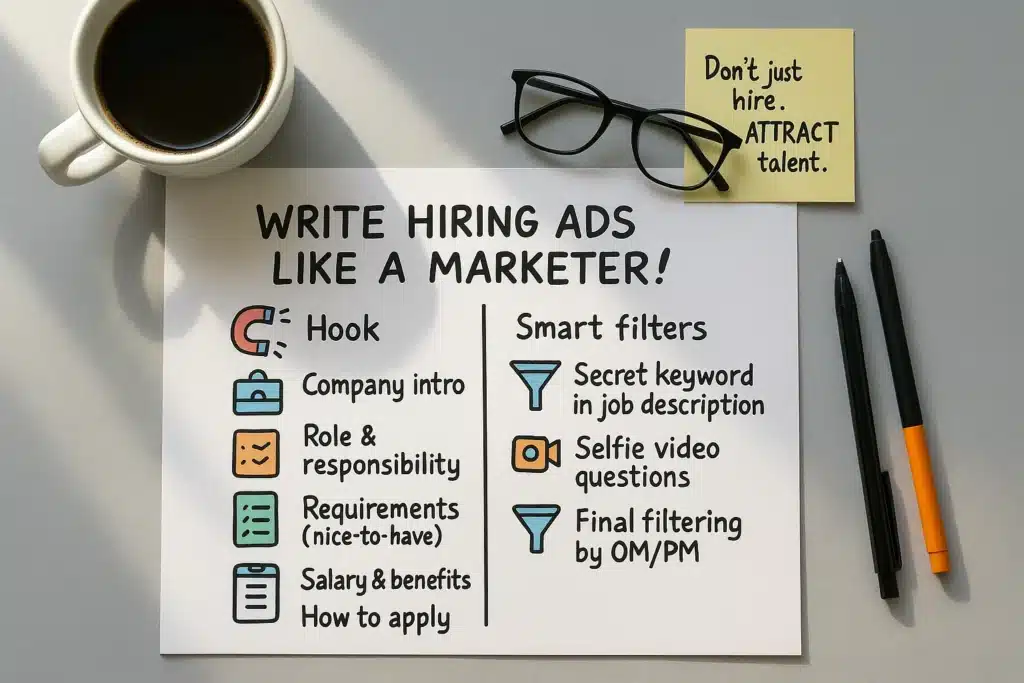
Optimizing Your Job Post – Write it Like Ad Copy!
Your job post isn’t just a list of requirements; it’s a sales pitch to attract top talent. Make it compelling!
Effective Job Post Structure:
- Hook: Start with an engaging question, a bold statement about the opportunity, or highlight the most exciting aspect of the role/your business.
- Company/Team Intro: Briefly introduce your business/brand. Be concise, convey your mission/values (even if you’re small), and create a positive impression.
- Role & Responsibilities: Clearly and specifically describe the daily tasks, key responsibilities, and expected outcomes. Avoid vague corporate jargon.
- Requirements (Must-Haves & Nice-to-Haves): Clearly list the essential skills, experience, and tools proficiency needed. Separate these from desirable but non-essential qualifications.
- Compensation & Benefits: Be transparent about the pay range (or project rate) and any benefits (even if just remote work flexibility). Mention performance incentives clearly.
- How to Apply: Provide clear, step-by-step instructions.
Crucial Filtering Mechanisms (Add these to your post):
“Secret Keyword”: Embed a specific, slightly unusual keyword (e.g., “blue pineapple”) somewhere in the job description and ask applicants to include it in their application subject line or first sentence. This instantly filters out anyone who didn’t read the post carefully.
Specific Questions: Ask 1-2 brief questions directly related to the role or a required skill that require more than a generic answer (e.g., “Briefly describe your experience optimizing Facebook ad creatives for CTR,” or “What project management tool are you most proficient with and why?”).
Video Selfie Intro (Optional but effective): Instead of just a CV, ask candidates to record a short (1-3 minute) video introducing themselves and answering 1-2 simple questions related to their experience or mindset (e.g., “What’s the biggest challenge you’ve overcome in a previous role?” or “Why are you interested in this specific role?”).
This helps assess communication skills, personality fit, and seriousness far better than text alone and saves hours compared to initial screening calls. *
Portfolio Review: For roles like Designer or Copywriter, the portfolio is paramount. Clearly state you require relevant work samples.
Remember: The hiring process itself should be efficient. Delegate the initial filtering (e.g., checking for the secret keyword, basic requirements) to your OM/PM or a trusted VA once they are onboard.
Conclusion: Building Your Team – Small but Mighty
Building an affiliate marketing team isn’t about empire-building; it’s about strategic leverage. It’s about freeing yourself from the tasks that drain your time and energy, allowing you to focus on the high-impact activities that truly drive growth and profitability.
Starting lean with these core roles – OM/PM, VA, Creative Designer, Copywriter, and Media Buyer – provides a powerful foundation. Each role addresses a critical function, and together, they form a synergistic machine capable of scaling your operations far beyond what you could achieve alone.
Don’t wait until you’re completely burnt out. Recognize the signs, identify your most critical needs, and start building strategically. Find the right people, empower them, create clear systems, and incentivize them based on results.
Transitioning from a solo operator to a team leader is a journey, often with its own challenges. But the reward – a scalable, sustainable business and greater personal freedom – is well worth the effort. Now, go build your A-team.
